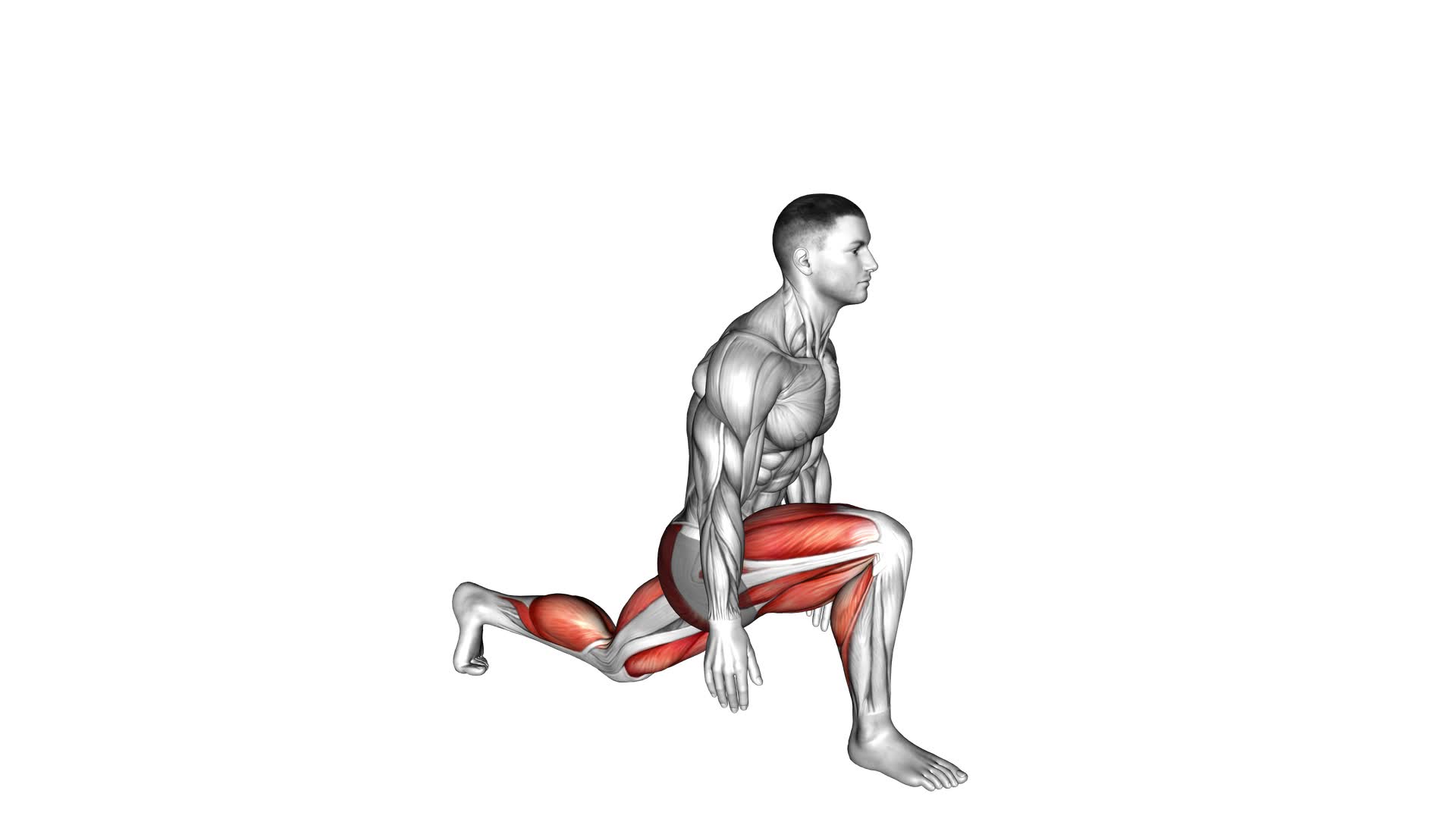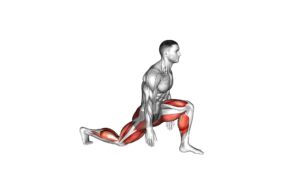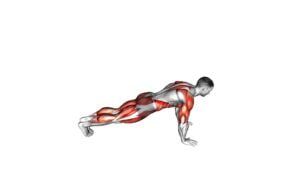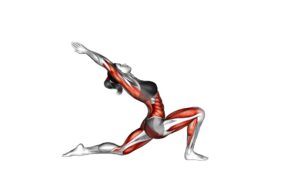Low Lunge (left) (male) – Video Exercise Guide & Tips

Get ready to level up your workout routine with the Low Lunge (left) exercise! In this video exercise guide, you'll find expert tips and techniques specifically tailored for men.
Watch This Exercise Video
Learn the proper form to maximize the benefits and avoid common mistakes. Discover modifications and variations to challenge yourself further.
Whether you're a beginner or a seasoned fitness enthusiast, incorporating the Low Lunge (left) into your routine will take your workout to the next level.
Let's get started!
Key Takeaways
- Low lunge (left) targets multiple muscle groups, including the quadriceps, hamstrings, and glutes.
- Proper knee alignment and balance are crucial for effective low lunge (left) execution.
- Engaging the muscles in the back leg helps maximize strength and stretch for the hip flexors.
- Modifications and variations can be made to accommodate individual needs and prevent strain or injury.
Benefits of Low Lunge (Left) for Men
You can experience several benefits from incorporating the low lunge (left) into your workout routine as a man.
The low lunge (left) is a versatile exercise that targets multiple muscle groups, making it an excellent addition to any fitness regimen. One of the primary benefits of this exercise is its ability to strengthen and tone your lower body, specifically your quadriceps, hamstrings, and glutes. By performing the low lunge (left), you can improve your leg strength and enhance your overall athletic performance.
Additionally, this exercise helps to improve your balance and stability, as it requires you to engage your core and maintain proper form throughout the movement.
Furthermore, the low lunge (left) can be modified and varied to suit your individual needs and fitness level. For beginners, you can start by using a chair or a wall for support, gradually increasing the depth of the lunge as you become more comfortable and stronger. On the other hand, if you're looking for a challenge, you can add weight by holding dumbbells or incorporating resistance bands into your routine. These modifications and variations allow you to continually progress and avoid plateaus in your fitness journey.
Proper Form and Technique for Low Lunge (Left)
To perform the Low Lunge (Left) exercise with proper form and technique, focus on two key points:
- Knee alignment and balance:
Ensure that your front knee is directly above your ankle, avoiding any inward or outward collapse. Maintain balance by keeping your core engaged and your torso upright.
- Engagement of the back leg:
Actively engage the muscles in your back leg, pressing through the heel to strengthen and stabilize the entire lower body.
Knee Alignment and Balance
Achieving proper knee alignment and balance is crucial for performing the low lunge (left) exercise with precision and efficiency. Maintaining knee stability is essential to prevent injury and ensure effective muscle engagement. When performing the low lunge (left), focus on keeping your front knee directly above your ankle, avoiding any inward or outward deviation. This alignment helps distribute the weight evenly and reduces stress on the knee joint.
Additionally, maintaining balance throughout the exercise is important for stability and control. By engaging your core muscles and focusing on your center of gravity, you can improve your balance and enhance the effectiveness of the low lunge (left).
Now that you understand the importance of knee alignment and balance, let's move on to the next section about back leg engagement.
Back Leg Engagement
To engage the back leg properly in the low lunge (left), ensure that you maintain a strong and stable stance. This will help you maximize back leg strength and get the most out of the hip flexor stretch.
As you lower into the lunge, make sure to keep your back leg active and engaged. Imagine pushing through your back foot and extending the leg straight while keeping the knee slightly bent. This will activate the muscles in the back leg, including the glutes and hamstrings, and provide a deeper stretch to the hip flexors.
Remember to maintain proper form and alignment throughout the movement to avoid any strain or injury.
Common Mistakes to Avoid During Low Lunge (Left)
Avoiding improper alignment is key when performing the low lunge (left) exercise.
One of the common mistakes to avoid during this exercise is incorrect knee alignment. It's crucial to ensure that your front knee is directly above your ankle and doesn't extend beyond it. This improper alignment can put excessive strain on your knee joint and increase the risk of injury. To avoid this mistake, focus on keeping your front knee in line with your ankle throughout the movement.
Another common mistake is allowing the front knee to collapse inward. This can lead to instability and compromise the effectiveness of the exercise. To prevent this, actively engage your outer hip muscles to maintain proper alignment.
Additionally, avoid sinking too deeply into the lunge, as this may cause unnecessary strain on your knee. Instead, aim for a comfortable depth that allows you to maintain proper alignment and control.
Modifications and Variations of Low Lunge (Left) for Men
To modify the low lunge (left) for men, pay attention to your knee alignment. Make sure your front knee is directly above your ankle, and avoid letting it collapse inward.
If you need extra support, try using props like blocks or bolsters under your hands or knees. These modifications will help you maintain proper form and prevent strain or injury during the exercise.
Knee Alignment Tips
For proper knee alignment in the low lunge (left) exercise, focus on maintaining a strong and stable position. Here are some tips to help you prevent knee injuries and modify the exercise for beginners:
- Align your front knee directly over your ankle to avoid any inward collapse or outward deviation.
- Engage your core muscles to stabilize your pelvis and prevent excessive forward or backward tilting.
- Keep your back knee in line with your hip and ankle, avoiding any excessive pressure on the joint.
By following these tips, you can ensure proper knee alignment in the low lunge (left) exercise, reducing the risk of injury and allowing beginners to safely participate.
Remember to listen to your body and make modifications as needed to maintain a comfortable and effective workout.
Prop Options for Support
Maintaining proper knee alignment in the low lunge (left) exercise is essential. Utilizing prop options for support can enhance stability and provide modifications and variations for men.
If you find it challenging to maintain balance or stability in the low lunge (left) position, using a chair modification can be helpful. Simply place a chair in front of you and rest your hands on it for support. This will allow you to focus on your form and prevent any unnecessary strain on your knees.
Another prop option is using blocks. Placing blocks under your hands can provide additional support and lift, making it easier to maintain proper alignment and engage your muscles effectively.
Experiment with different prop options to find the one that suits your needs and helps you perform the low lunge (left) exercise with confidence.
Tips for Incorporating Low Lunge (Left) Into Your Workout Routine
Add the low lunge (left) to your workout routine for increased flexibility and strength. Here are some tips for incorporating this exercise into your routine:
- Start with a warm-up: Before performing the low lunge (left), it's important to warm up your muscles. Engage in light cardio exercises like jogging or jumping jacks to get your blood flowing and prepare your body for the workout.
- Modify as needed: If you're new to fitness or have limited flexibility, you can modify the low lunge (left) by keeping your back knee on the ground. This will still provide a great stretch for your hip flexors and quadriceps.
- Use proper form: When performing the low lunge (left), make sure to keep your front knee directly above your ankle and your back leg extended behind you. Engaging your core and maintaining a straight back will help you get the most out of this exercise.
Incorporating the low lunge (left) into your beginner's workout routine offers numerous benefits for flexibility training. This exercise targets the hips, quadriceps, and hamstrings, helping to improve their range of motion. The low lunge (left) also engages the core muscles, enhancing stability and balance. By regularly incorporating this exercise into your routine, you can gradually increase your flexibility and strength, leading to improved overall fitness.
Recommended Sets, Reps, and Frequency for Low Lunge (Left) (Male)
To effectively incorporate the low lunge (left) into your workout routine, aim for three sets of 10 repetitions per session, and perform this exercise two to three times a week. The low lunge (left) is a versatile exercise that targets multiple muscle groups, including the quadriceps, hamstrings, glutes, and hip flexors. It also helps improve balance, flexibility, and stability in the lower body.
For men, performing three sets of 10 repetitions per session is a good starting point. However, you can increase the number of sets and repetitions as you progress and become more comfortable with the exercise. It's important to listen to your body and make adjustments accordingly.
Recommended modifications for the low lunge (left) include using a yoga block or cushion under your knee for added support and comfort. Additionally, you can use dumbbells or a barbell to add resistance and make the exercise more challenging.
While the low lunge (left) is often associated with male athletes and fitness enthusiasts, it also offers several benefits for women. This exercise helps strengthen the muscles of the lower body, which can be particularly beneficial for women who are looking to tone their legs and glutes. It can also improve hip flexibility, which is important for maintaining good posture and preventing injuries.
Incorporating the low lunge (left) into your workout routine can help you achieve your fitness goals and enhance overall strength and mobility.
Frequently Asked Questions
Can Women Also Perform the Low Lunge (Left) Exercise?
Yes, women can absolutely perform the low lunge (left) exercise. It's a versatile workout that targets the lower body and helps improve flexibility and strength.
There are modifications and variations available for the low lunge to suit different fitness levels and goals. By incorporating low lunge modifications and trying out variations for low lunge, women can customize the exercise to their specific needs and preferences.
Is It Necessary to Warm up Before Doing the Low Lunge (Left) Exercise?
Before diving into the specifics of the Low Lunge (left) exercise, let's talk about the importance of warming up.
When it comes to any exercise, warming up is crucial to prepare your muscles and joints for the upcoming movements. It helps increase blood flow, flexibility, and reduces the risk of injury.
Now, let's move on to the benefits of the Low Lunge (left) exercise and some modifications you can make to suit your needs.
Can the Low Lunge (Left) Exercise Help With Improving Flexibility?
The low lunge (left) exercise is great for improving flexibility. By stretching your hip flexors and quadriceps, it helps increase your range of motion. This can lead to improved balance and stability in other exercises and daily activities.
Additionally, there are variations of the low lunge that can target different muscle groups and intensify the stretch. Incorporating these variations into your routine can further enhance your flexibility and overall fitness.
How Does the Low Lunge (Left) Exercise Benefit the Muscles in the Lower Body?
The low lunge (left) exercise is great for your lower body muscles. It targets your quadriceps, hamstrings, glutes, and hip flexors. By incorporating low lunge variations into your workout routine, you can improve your lower body strength, flexibility, and balance.
It also helps to stretch and lengthen the muscles in your legs, which can reduce the risk of injury and improve overall athletic performance.
Are There Any Precautions or Contraindications for Individuals With Knee or Hip Issues When Performing the Low Lunge (Left) Exercise?
When performing the low lunge (left) exercise, it's important to be aware of any knee or hip issues you may have. There are precautions and contraindications that should be considered.
If you have knee or hip problems, it's advisable to consult with a healthcare professional before attempting this exercise. They can provide guidance on modifications or alternatives that will allow you to work out safely and effectively.
Your safety and well-being should always be a top priority.
Conclusion
Incorporating the low lunge (left) into your workout routine can offer numerous benefits for men. It helps improve lower body flexibility, strengthens the legs, and stretches the hip flexors.
By maintaining proper form and avoiding common mistakes, you can maximize the effectiveness of this exercise. Additionally, modifications and variations can be made to suit individual fitness levels and goals.
Including the low lunge (left) in your regular routine can help enhance overall strength and flexibility.

Author
Years ago, the spark of my life’s passion ignited in my mind the moment I stepped into the local gym for the first time. The inaugural bead of perspiration, the initial endeavor, the very first surge of endorphins, and a sense of pride that washed over me post-workout marked the beginning of my deep-seated interest in strength sports, fitness, and sports nutrition. This very curiosity blossomed rapidly into a profound fascination, propelling me to earn a Master’s degree in Physical Education from the Academy of Physical Education in Krakow, followed by a Sports Manager diploma from the Jagiellonian University. My journey of growth led me to gain more specialized qualifications, such as being a certified personal trainer with a focus on sports dietetics, a lifeguard, and an instructor for wellness and corrective gymnastics. Theoretical knowledge paired seamlessly with practical experience, reinforcing my belief that the transformation of individuals under my guidance was also a reflection of my personal growth. This belief holds true even today. Each day, I strive to push the boundaries and explore new realms. These realms gently elevate me to greater heights. The unique combination of passion for my field and the continuous quest for growth fuels my drive to break new ground.







